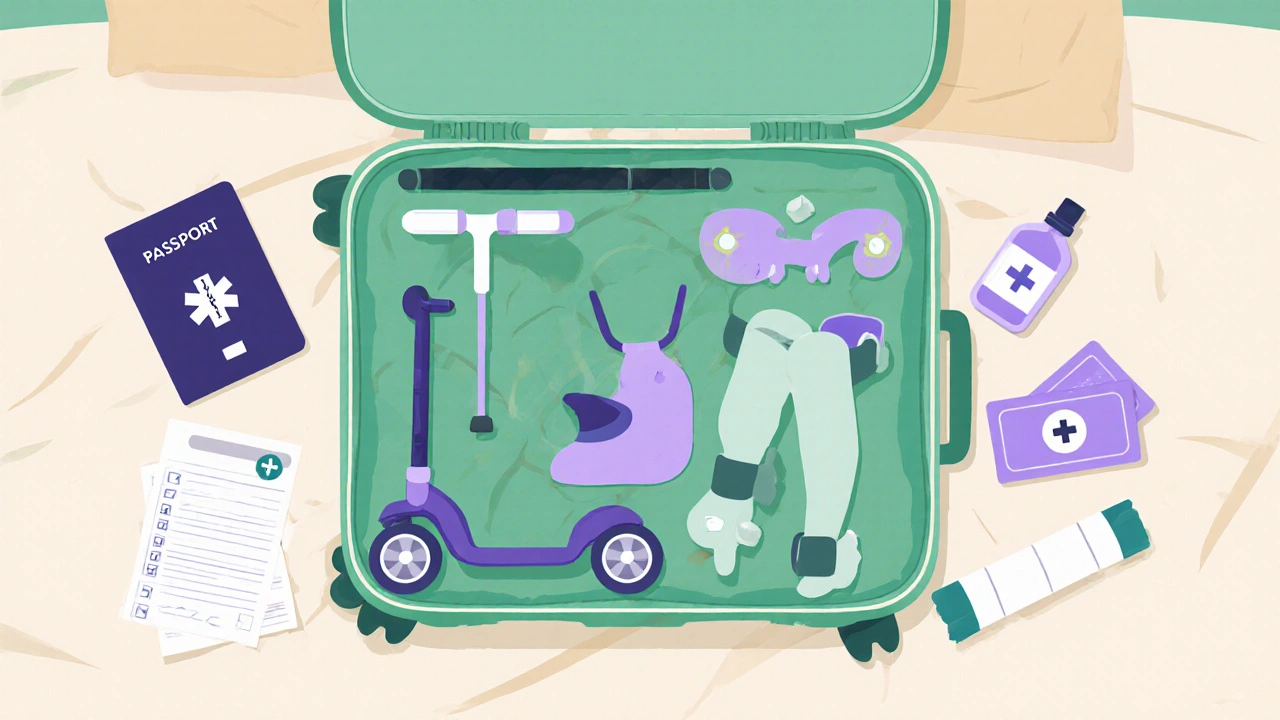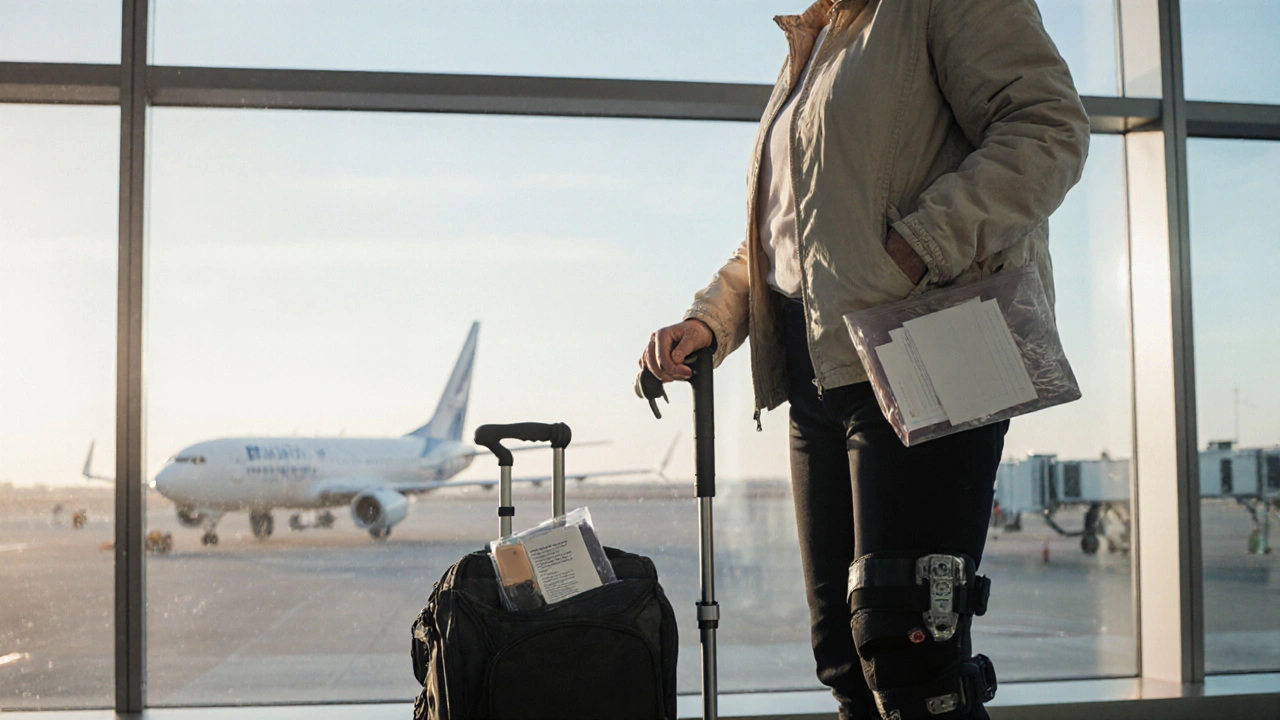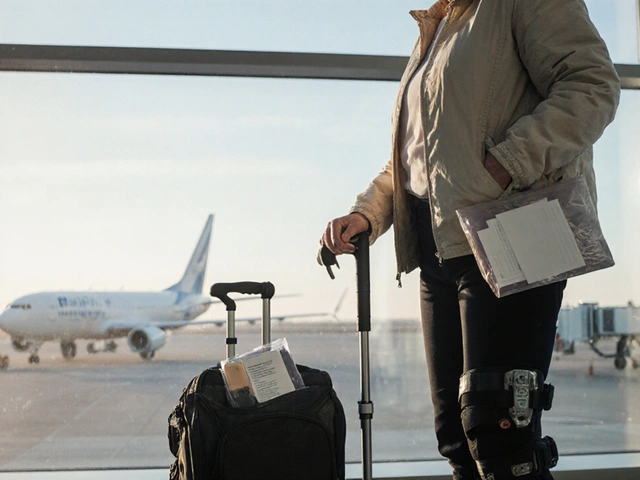Osteoarthritis Travel Planner
Your Personalized Travel Plan
Imagine boarding a flight, hopping on a train, or strolling through a new city while battling stiff joints and unpredictable pain. For people living with osteoarthritis travel, the excitement of discovery can quickly turn into a logistical nightmare. The good news? With a bit of forethought and the right tools, you can enjoy the journey without letting your joints call the shots.
Key Takeaways
- Schedule a doctor’s check‑up and update prescriptions at least two weeks before departure.
- Pack a travel‑specific arthritis kit that includes medications, compression sleeves, and portable heating/cooling packs.
- Choose mobility aids that balance support with portability; a lightweight folding cane often wins the portability race.
- Secure airline and hotel accommodations that guarantee extra legroom, wheelchair assistance, and accessible rooms.
- Adopt pacing strategies-walk in short bursts, hydrate frequently, and listen to your body’s signals.
Understanding Osteoarthritis
Osteoarthritis is a degenerative joint disease that gradually wears down cartilage, leading to pain, swelling, and reduced range of motion. It most commonly affects the knees, hips, hands, and spine, and its symptoms can flare up after prolonged inactivity or excessive loading.
Because the condition is chronic, everyday activities-let alone travel-require a plan that minimizes stress on the joints while preserving flexibility.
Pre‑Travel Planning: The Foundation of a Smooth Trip
Successful trips start long before you set foot on a plane. Follow this checklist to keep your health on track:
- Medical Clearance: Book an appointment with your rheumatologist or primary care physician at least two weeks before you travel. Discuss your itinerary, ask about any medication adjustments, and request a concise medical summary for emergencies.
- Medication Management: Ensure you have a 30‑day supply of oral NSAIDs, disease‑modifying drugs, or any prescribed supplements. Carry them in their original packaging and keep a printed list of doses.
- Travel insurance with a clause for pre‑existing conditions can cover unexpected doctor visits abroad. Verify that the policy includes coverage for physiotherapy and medication refills.
- Flight & Accommodation Requests: Contact airlines 48hours ahead to request wheelchair assistance, extra legroom, or pre‑boarding. Book hotels that advertise ADA‑compliant rooms, roll‑in showers, and ground‑floor access.
- Document Pack: Prepare a travel health folder that includes your medication list, doctor’s letter, insurance card, and a copy of your diagnosis.

Packing Smart: Mobility Aids & Comfort Gear
Choosing the right aid makes a huge difference in how far you can go without exhausting yourself.
| Aid | Weight | Portability | Battery/Power | Best Terrain |
|---|---|---|---|---|
| Cane (foldable) | 0.5kg | Fits in a carry‑on | None | Urban sidewalks, indoor |
| Four‑wheel walker | 3kg | Disassembles into two parts | None | Flat surfaces, airports |
| Motorized scooter | 12kg | Foldable, but may need checked baggage | Rechargeable battery (≈8h) | City streets, mild inclines |
For most short trips, a lightweight folding cane or a compact walker offers enough support without adding bulk. If you anticipate long days of standing or uneven terrain, a motorized scooter-though heavier-provides continuous assistance.
Don’t forget mobility aid accessories such as a protective sleeve, quick‑release tips, and a carrying case that meets airline size limits.
Managing Pain On The Move
Enough about equipment-now let’s talk pain control.
NSAIDs (e.g., ibuprofen, naproxen) remain the frontline oral option for flare‑ups. Take them with food, stay within the prescribed dosage, and set an alarm on your phone to keep a consistent schedule.
Topical treatments can be a game‑changer when you can’t swallow a pill. Bring a small tube of diclofenac gel or a menthol‑based cream to apply to knees or hands after a long walk.
Compression sleeves, especially those designed for the knees, help reduce swelling by improving blood flow. Look for breathable fabrics that stay in place during movement.
Finally, pack a set of reusable hot and cold packs. Warm them up in a hotel’s microwave for a soothing heat session; chill them in a mini‑fridge for pain‑relieving cold therapy.
Navigating Airports & Flights
Air travel brings its own set of challenges, from tight seating to security checkpoints.
When you arrive at the airport, head to the assistance desk and present your airline confirmation. Request a wheelchair from curb to gate if you’re using a walker or scooter; most carriers will provide this service at no extra cost.
At security, clearly place your medications in a separate, transparent bag. TSA officers are accustomed to travelers with medical needs and will often allow you to keep your medication in the carry‑on.
Once on board, claim any extra legroom seats you’ve booked. If you didn’t pre‑book, politely ask a flight attendant if a row with fewer passengers is available.
During the flight, stand up and stretch every 30-45minutes. Use your aisle seat to gently flex knees and hips, and keep a small pillow to support your lower back.

Staying Flexible at Your Destination
Arriving at your hotel is the perfect moment to set up a comfortable base.
Hotel accessibility features to look for include roll‑in showers, grab bars, and wide doorways. Call ahead to confirm these details; many hotels will happily arrange a room on a lower floor with a bathroom that meets accessibility standards.
Plan daily activities around low‑impact options: museums, guided bus tours, or river cruises that limit walking. If you want to explore on foot, map out rest stops every 15‑20 minutes and carry a water bottle to stay hydrated-dehydration can worsen joint pain.
Adjust your diet to include anti‑inflammatory foods such as salmon, walnuts, and leafy greens. These choices can subtly reduce systemic inflammation and improve overall comfort.
Everyday Tips While Exploring
- Pace Yourself: Adopt the "20‑minute rule"-walk for 20 minutes, rest for 5, then repeat. This prevents sudden joint overload.
- Use Elevators: Even if stairs are tempting, elevators reduce impact on knees and hips.
- Carry a Small Backpack: Distribute weight evenly and avoid over‑loading a single side.
- Apply Heat Before Activity: Warm the joints for 10 minutes with a heating pad or warm towel to improve flexibility.
- Cold Therapy After Long Days: Use ice packs on sore knees to cut down swelling.
Remember, the goal isn’t to eliminate all discomfort-just to keep it at a level that lets you enjoy the sights, sounds, and flavors of your trip.
Frequently Asked Questions
Can I travel with a motorized scooter on a plane?
Yes, but you’ll need to book it as special equipment. Most airlines allow you to check the scooter for free if you provide a medical letter. Arrive early to complete any required paperwork.
What should I do if my medication runs out abroad?
Contact the local pharmacy with your doctor’s prescription. Many countries accept electronic prescriptions, and your travel insurance can help cover the cost.
Do I need a doctor’s note for airport wheelchair assistance?
A note isn’t required for standard mobility aids, but having one can speed up the process, especially if you use a power scooter.
How can I reduce swelling after a long day of sightseeing?
Elevate your legs while sitting, apply a cold pack for 15 minutes, and wear compression sleeves. Gentle ankle pumps can also promote circulation.
Is it safe to take NSAIDs while flying?
Generally yes, as long as you follow the prescribed dose and take it with food. If you have a history of stomach ulcers, talk to your doctor about taking a proton‑pump inhibitor alongside.



Traveling with OA? Pack extra meds and a comfy seat cushion.
It is incumbent upon individuals with osteoarthritis to approach travel planning with utmost deliberation.
One must prioritize ergonomic accommodations over momentary convenience.
The moral imperative to safeguard one's body extends beyond personal comfort; it reflects a duty to society.
Furthermore, adherence to a regimented medication schedule is non‑negotiable.
✈️😊
Travel, when viewed through the lens of national pride, becomes a testament to our resilient spirit.
The ancient philosophers taught that physical limitation does not diminish the pursuit of exploration.
One must therefore equip oneself with sturdy support devices, for they symbolize the nation's engineering prowess.
Moreover, selecting destinations with accessible infrastructure showcases the progress of our civilization.
By embracing assistive technology, travelers embody the very ingenuity that defines our country.
The journey itself becomes a subtle proclamation of collective advancement.
Let us march onward, remembering that each step taken with aid is a step for the nation.
Oh the agony of a swollen knee on a mountain trail the drama is real the pain feels like fire but the will to see new horizons fuels the soul.
Every step becomes a saga a battle between flesh and fire.
Yet the heart refuses to surrender the mind visualizes the summit.
Even the simplest bench at a rest stop becomes a throne for the weary.
I tell you the travel saga continues despite the throbbing echo in the joints.
Hey buddy, I get it, traveling with osteoarthritis can feel like a marathon before the race even starts.
First thing, make sure you have a travel-sized pill organizer so you don’t miss a dose when you’re on the go.
Pack a portable heat wrap, it’s a lifesaver on those long flights or road trips when the joints get stiff.
Don't forget to bring a sturdy, folding cane that fits in your carry‑on; it’s less of a hassle than dragging a heavy walker.
If you can, schedule a quick physiotherapy session at your destination – a lot of clinics offer short consults for travelers.
Stay hydrated, water helps keep the cartilage lubricated and reduces pain spikes.
Aim for early morning departures, the temperature is usually cooler and less swelling tends to happen.
When you’re at the airport, look for seating with armrests and a little extra cushion – it makes a world of difference.
Take short walks every hour if you’re on a long bus ride, it prevents stiffness from setting in.
Use compression sleeves on your knees and wrists, they give gentle support without restricting movement.
Always have a backup pair of shoes, comfy sneakers are better than dress shoes for a day of walking.
If you’re heading abroad, check if your insurance covers mobility aids – you don’t want surprise costs later.
Remember to set a daily reminder on your phone for medication and stretch breaks, technology can be your ally.
Lastly, keep a positive mindset – a smile and a strong support system can turn a challenging trip into a memorable adventure.
And hey, if something goes sideways, just call a friend or a travel companion, we’re all in this together.
They probably hide the real side effects from us.
Esteemed travelers, it is imperative to schedule regular rest intervals during extended journeys.
Incorporating low‑impact activities such as swimming can mitigate joint inflammation.
Selecting accommodations with wheelchair‑friendly access demonstrates prudent planning.
Remember, consistency in medication intake remains paramount.
Safe travels and may your adventures be both joyous and pain‑free 😊🚀
While the intent is commendable, the phrase “non‑negotiable” should be hyphenated, and “one must prioritize” would read better as “one should prioritize.”
Additionally, “It is incumbent upon individuals” is overly verbose; consider “Individuals should.” These adjustments enhance clarity.
Contrary to popular advice, the rigidity of excessive planning often stifles the spontaneity that healing thrives upon.
Over‑reliance on assistive devices can engender a psychological dependence that hampers natural adaptation.
Moreover, the emphasis on scheduled medication disregards emerging research on intermittent dosing benefits.
One might argue that embracing occasional discomfort fosters resilience rather than perpetual avoidance.
Thus, a balanced approach, rather than strict adherence, may better serve those with osteoarthritis.
Honestly I think you’re missing the point completely.
People with osteoarthritis need practical help, not philosophical debate.
The reality is that without proper support the pain becomes unbearable and daily tasks become impossible.
Your suggestion to “embrace occasional discomfort” is naive and could lead to serious injury.
It’s not about building resilience by ignoring pain; it’s about managing pain so you can live a functional life.
So please stop romanticizing suffering and focus on proven strategies that actually work.
The community deserves clear, actionable advice, not abstract theory.
The whole travel planner is a sham.
Only corporate interests profit while users get gimmicky tips.
Actually the program was developed by a reputable physio team, not some profit‑driven scam.
It includes evidence‑based recommendations, so calling it a sham is misleading.
Also, the “gimmicky tips” are backed by clinical guidelines.
You might want to check the sources before throwing around accusations.